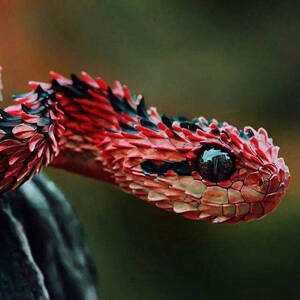Acrochordus granulatus
IUCN
LCBasic Information
Scientific classification
- name:Acrochordus granulatus
- Scientific Name:Acrochordus granulatus,Wart-scaled snake
- Outline:Squamata
- Family:Scrofaidae Scrofacoidea
Vital signs
- length:60-250cm
- Weight:No verification information
- lifetime:No verification information
Feature
It is a species of snake that lives entirely in water.
Distribution and Habitat
The main distribution area of the scrofula snake is from India and Sri Lanka in the west to the tropical regions of Southeast Asia and the Philippines; in the south to Indonesia, Malaysia, and Timor; in the east to New Guinea, the north coast of Australia, Guadalcanal Island, and the Solomon Islands.
Appearance
The total length of females is 1000mm, and the tail accounts for 1/10 of the total length. The head is gray-black, and the back of the body and tail is gray-white with black rings or black horizontal stripes. The head is small and not clearly distinguished from the neck. The back of the head is covered with small scrotal scales, and the snout is slightly larger; the nostrils are located on the snout, open upward, round, and surrounded by ring-shaped nose scales; the eyes are small, located on the back of the head, and there are 8 to 11 scales in a horizontal row between the two eyes, and the pupils are upright and oval. The body is stout and slightly flattened laterally, especially in the posterior section; the skin of the whole body is loose, covered with small scrotal scales, and there are about 100 scales around the middle of the ring body; there are no large ventral scales, and the skin along the center of the ventral surface forms a fold covered with very small spinous scales. The
Details
Little wart snake (pinyin: luǒ lín shé), English name: Little wart snake, is a snake species that lives entirely in water.

The main food of the scrofula is fish, but there are a lot of these snakes, and they live in groups, so when fishermen fish, they will also salvage the scrofula, and many fishermen initially thought it was an eel. Compared with its peers, the scrotal snake is very good at swimming. The main reason is that its skin is very loose. It is very good at hunting. Sometimes it will lurk in the riverbed, waiting for the prey to approach slowly, and then attack with one move, biting the prey tightly until the prey can't breathe and dies.
The scrotal snake is an oviparous animal. It lays eggs in October every year. It can lay up to eight snakes each time. The length of the newly born snake is 220 mm. The newly born snake cannot go out to find food, nor can it crawl. It can be said that the newly born snake cannot even open its eyes. Females and males will mate in caves and lay eggs in caves. The nest of the scrotal snake is very simple, and generally chooses a large tree hole or a cave.
The nest of the scrofula snake is not covered with any material, so the eggs usually fall directly to the ground and are incubated by the female. The entire incubation process takes about 25 days. The little snake can find food on its own after one month, and can open its eyes and crawl on its own after half a month. When the little snake reaches sexual maturity, it will separate from its parents and find a partner, and start a new round of reproduction.
The scrofula snake was listed as a key wild animal in 2000, and was also added to the Red List, which is a near-threatened animal. At the same time, the state has also formulated some criminal sanctions for hunters. Many criminals use the skin of scrofula snakes to make bags, resulting in a gradual decrease in the number of scrofula snakes.
Listed in the "National List of Terrestrial Wildlife with Important Economic and Scientific Research Value" issued by the State Forestry Administration of China on August 1, 2000.
Listed in the 2013 Red List of Endangered Species of the World Conservation Union (IUCN) ver3.1--Near Threatened (NT).
Listed in the China Biodiversity Red List-Vertebrate Volume, with an assessment level of Vulnerable (VU).
Listed in the second level of the "National Key Protected Wildlife List of China".
Protect wild animals and stop eating game.
Maintaining ecological balance is everyone's responsibility!








